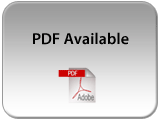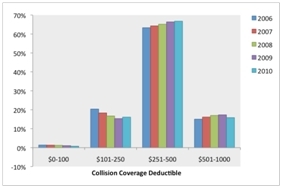SAN FRANCISCO, CA--(Marketwire - March 29, 2011) - Quality Planning, a company that validates policyholder information for auto insurers, has published findings from a recent study conducted to determine whether the economic recession led consumers to take on more risk in order to trim car insurance expenses. The study, now available at www.qualityplanning.com, finds that the number of consumers who saved on their auto insurance by opting to not purchase collision and comprehensive insurance rose sequentially from 2006 to 2010, especially for older vehicles. In addition, when consumers elected to purchase collision and comprehensive insurance, Quality Planning found significant increases in the number of consumers who opted for higher deductibles, thereby reducing their immediate out-of-pocket auto insurance costs but placing them at risk of economic hardship in the event of a loss. Quality Planning is a member of the Verisk Insurance Solutions group at Verisk Analytics.
Consumers gamble on older cars and drop expensive coverage
Between 2006 and 2010, American consumers spent an average of $721 per vehicle to insure it. During that period, the average insurance cost for new (current model year) vehicles was $913 -- significantly higher than the average insurance cost of $528 for older vehicles (defined as a vehicle that is ten or more years older than the year under study). Quality Planning discovered that, for new vehicles, most policyholders purchased complete coverage, that is, liability, collision, and comprehensive. There were very few instances where optional coverage types, namely comprehensive and collision, were dropped as a cost-cutting measure. This is likely because lienholders (such as banks and credit unions) required those coverage types or because new vehicle owners were more risk-averse and did not wish to risk losses on their newer and more expensive vehicles.
Conversely, for older vehicles, Quality Planning found that policyholders were more willing to drop relatively pricey comprehensive and collision coverage. For the period 2006 to 2010, Quality Planning found that the average percentage of older vehicles without collision or comprehensive coverage increased from 53 percent to 63 percent. For consumers, this yielded a monthly out-of-pocket savings of $19 a month, or $229 annually.
Consumers elect to shoulder more personal risk with higher deductibles
Another cost-cutting insurance tactic available to households is to adjust the collision coverage deductible -- the amount the policyholder must pay out of pocket before the insurance policy begins to pay. A lower deductible costs more than a higher one, so Quality Planning investigated what effect, if any, the recession had on the amount of risk consumers were willing to assume with respect to auto insurance.
Again, the research reveals a shift toward less expensive (but more risky) selections. From 2006 to 2009, Quality Planning found that the percentage of vehicles with low collision coverage deductibles ($0 to 100 and $101 to 250) steadily declined at an average annual rate of approximately 9 percent, while those vehicles with higher deductibles ($251 to 500 and $501 to 1000) steadily increased at an average of between 1.6 and 4.9 percent per year.
Most of the decline was in the $101 to 250 deductible bracket as consumers moved into higher deductible brackets. However, in 2010, this downward trend changed noticeably: The percentage of vehicles with a $101 to 250 deductible actually increased slightly from its 2009 low point, offsetting a similar decrease in the percentage of vehicles with a $501 to 1,000 deductible. Owners of new cars often purchase lower deductibles to protect their sizable investment. Although all model years continued to move toward higher deductibles, the 2010 spike in new car sales that resulted from the "Cash for Clunkers" program and other sales incentive programs sponsored by U.S. manufacturers caused the dip in the highest deductible category because 2010 new cars represented a higher percentage of total vehicles than in previous years.
Study Methodology
For this study, Quality Planning examined policies from 2006 through 2010. Relevant fields included vehicle model year, premium for each type of coverage, and respective deductible limits. For the full five-year period under study, the total sample size included 59.8 million vehicles. With vehicle model year as the basis, QPC designated two categories of vehicles for the study:
- New vehicles -- vehicles where the model year was the same as the year of analysis. That is, when Quality Planning examined 2006 policy data, a new vehicle was one where the vehicle model year was also 2006.
- Older vehicles -- vehicles where the model year was up to 10 years older than the year under study. For example, if the year under study was 2008, then older vehicles were those of model years 1998 or older.
About Verisk Analytics
Verisk Analytics is a leading provider of information about risk to professionals in insurance, healthcare, mortgage, government, and risk management. Using advanced technologies to collect and analyze billions of records, Verisk Analytics draws on vast industry expertise and unique proprietary data sets to provide predictive analytics and decision-support solutions in fraud prevention, actuarial science, insurance coverages, fire protection, catastrophe and weather risk, data management, and many other fields. In the United States and around the world, Verisk Analytics helps customers protect people, property, and financial assets. For more information, visit www.verisk.com.
About Quality Planning
Quality Planning is focused on providing rating integrity solutions to auto and home insurers. A member of the Verisk Insurance Solutions group at Verisk Analytics, Quality Planning works with insurance companies to identify areas of significant rating error using sophisticated database management, statistical analysis and modeling, customized survey design, and highly targeted customer interaction. Quality Planning helps clients work within their existing rating plans and charge fair prices to policyholders based on a true representation of risk. The company was founded in 1985 and is headquartered in San Francisco. For more information, visit www.qualityplanning.com.
Contact Information:
Contact:
Tim Cox
ZingPR
650-369-7784


